
Diffrent types of conch or Shankh of Indian deities
A month ago, I posted an article on significance of Shankh. In this article, I will explain on different types and shankh and its importance in Hindu philosophy
Spiritual significance of shankh in Hinduism
Shankh is one of the eight auspicious symbols in Hinduism, collectively known as ashtamangala. Similar to swastika, shankh is the sacred symbol of Vedic religion. Conch and other similar instruments are primarily blown to produce auspicious sounds that drive away all negative vibrations that disturb the mind of devotees. Sound produced from shankha is called shanknad(There is a popular internet group named ‘shanknad’ that posts interesting videos on Indian culture and also manages FB page of subramaniam swamy, a well known BJP leader and Hindu social activist)
शङ्खशब्दो भवेद्यत्र तत्र लक्ष्मीश्च सुस्थिरा ।
सुस्नातः सर्वतीर्थेषु यस्नातः शङ्खवारिणः ॥ (Brahmavaivarta P. 20.28)
The sound of conch is conductive to gaining wealth and the one who takes bath with the water from conch earns the merit of taking bath at all holy places.
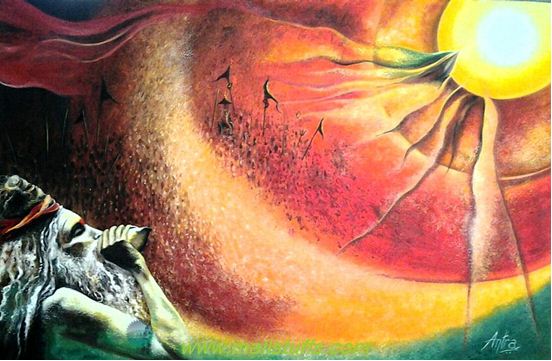
Image courtesy: Antra Srivastava
@ https://fineartamerica.com/featured/shankhnaad-antra-srivastava.html
Types of Shankh
Shankh can be both right handed as well as left handed. Right handed shells are said to preservative in nature and left handed ones are believed to be destructive in nature. This is the reason why Right handed shells are said to be the shell of lord Vishnu(Preserver) and left handed shells are said to be the shell of lord Shiva(Destroyer).
Ganesha Shankha
Ganesha shankha is one of the largest worshipped shankh and is used to honor lord ganesha- the remover of obstacles. This shankh is blown to ward off evil effects and invoke prosperity and happiness in the house. This shankh is kept in locker, Puja Room (place of worship) or any similar place that should be free from evil eyes. Before blowing this conch, Lord Shiva and goddess Parvati are worshiped. This shankh is very rare in nature and the person finding it naturally is believed to very lucky. This shankh should be wrapped in red cloth to maximize the positive effect of emanating sound vibrations. This shankh imbibes confidence, fame, happiness, wisdom, good health and long life. According to Feng Shui, this shankh is best for businessman and professionals who wish to settle abroad.
Dakshinavarti Shankha
Right handed shankh is also known as Dakshinavarti Shankhas as it has the distinct feature of brown lines flowing toward the south (Dakshina). As lord kuber(Deity of wealth) lived in southern India (Lanka), Right handed Shankha represents wealth and prosperity. Adorned with great virtues, Dakshinavarta shankh is regarded as the greatest of all shankhas. Dakshinavarti Shankh is found very deep in the sea and so is very rare and auspicious. Keep it wrapped in the white cloth to invoke prosperity and success to the individual and family. Dakshinavarti shankh fills the house with wealth and blessings of goddess Lakshmi.
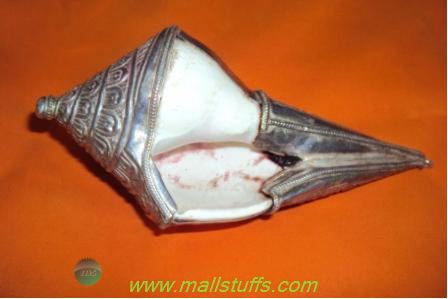
According to Varaha Purana, bathing with conch water of Dakshinavarta frees the person of all sins. Skanda purana further declares the removal of sins committed in all the previous seven lives.
Vamavarti Shankha
Left handed shankhas are known as Vaamavarti Shankhas. These are abundantly available in nature and are of Vaamvarti type. Vaamvarti are the conches whose bulge faces north, opening towards the left side. This shankh if placed at a correct location in the house removes all the negative energies from the house. This is why it is used in sri Yantra to create a positive energy field.
Kauri Shankha
Kauri shankh was one of the holy objects that emerged from the churning of the ocean. Since ancient times, it has been used in marriages and engagements to wish luck, success and prosperity to the bride/groom. Small kauri shankh can be seen in the wedding attire of the bride. In ancient times, Kauri shankh was used as the currency in barter trade. Structure of Kauri shankh is very similar to hair of Lord Shiva. Nandi-the guardian installed in lord Shiva temple is beautifully decorated with Kauri shankh. This shankh is kept in cash counter and cash lockers to invite prosperity and protect the business from financial debacle.
Gaumukhi Shankha
Gau means ‘Cow’ and mukh means ‘Face’. Hence Gaumukhi Shankh means “Conch with face of cow”.
As Cow is regarded a very sacred animal in Hinduism, this shankh is said to lavish all the benefits one normally gets from keeping the cow.
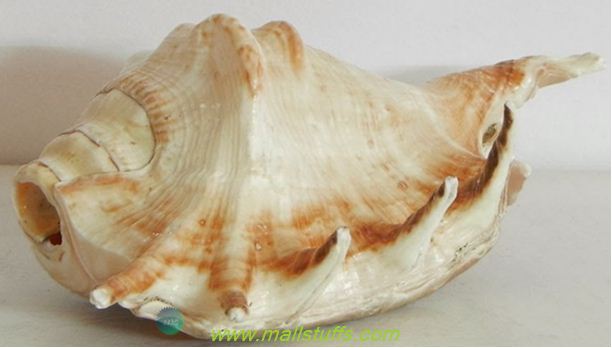
Sthri Shank or Shankini
This shankha is rarely used in religious ceremonies. Due to its tough thorn like covering surrounded by retrograde circles, this shankh does not produce good sounds. This conch is not used by priests but is used by aghoris in their daily practice.
Heera Shankha
This Shankha is known as Pahadi Shankha as it is found in the mountainous regions. Outer crust of this shankh is very dull but the inner crust shines like diamond and the opening has a sparkling crystal like substance. Due to its rarity and sparkling surface, this is the costliest of all shankhas.
साधारं शङ्खमपि च संपूज्य कुसुमादिभिः ।
निःक्षिपेदस्रवर्णाभ्यां शोधितं तत्र सज्जलम् ॥ (Shiva Purana. 6.18.19)
Rest conch on a support, offer flowers to conch, Fill it with water and after getting water strained, cover conch with protective measures
Moti Shankha
This shankh that shines like a Moti (pearl) is extremely rare to find. This is so rare that only 1 in 20,000 shankhas are of this type and only 1/10 of such types are good enough to be blown.
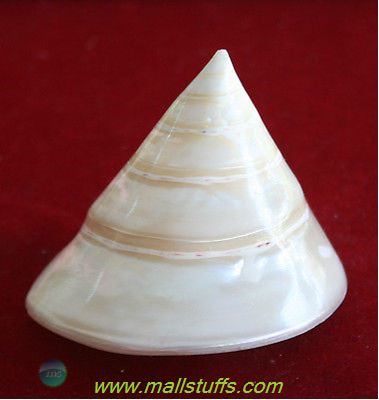
Vamavrati Shank
This is the most commonly used Shankh in spiritual practices. Astrologers advise worship of this conch to eliminate the effect of evil planets and instill victory, peace, success, health and wealth.
आलोकनेन द्रव्याणि शुद्धिं यान्ति न संशयः । (Garuda P. 1.48.23)
By the gaze at the conch a person becomes pure.
Shankh of Indian deities and warriors
Shankh is regarded as one of the auspicious objects that emerged from the churning of the ocean. Many Indian deities have shankh as one of their primary sacred objects.
Conch-Dwelling place of deities
Conch shells is said to be the abode of many deities. Brahma on the seat, Chandra at the tip and surya(Sun) in the middle. Deities like Vayu, Agni, Aditya, varuna and Soma at the right side of Shankha, Prajapati on the back side and goddess ‘Ganga’ and ‘Sarasvati’ on the front side.
शङ्खादौ चन्द्रदैवत्यं कुक्षौ वरुणदेवता ।
पृष्ठे प्रजापतिश्चैव अग्रे गङ्गा सरस्वती ॥
त्वं पुरा सागरोत्पन्ना विष्णुना विधुतः करे ।
अग्रतः सर्वदेवानां पाञ्चजन्य नमोस्तुते ॥
(Moon dwells at the base of conch shell, Varuna in the Kukshi, Prajapati on the back of the conch and Ganga - Saraswati at the mouth. O Panchajanya, you arose from the ocean and lord Vishnu has held you in his hand. You are ahead among the gods, hence I salute you.)
Conch of Mahabharata warriors
Each of the Mahabharata warriors had their own special Conch.
Conch of Lord Krishna was called Paanchajanya whereas conch of arjuna was called as Devdutta.
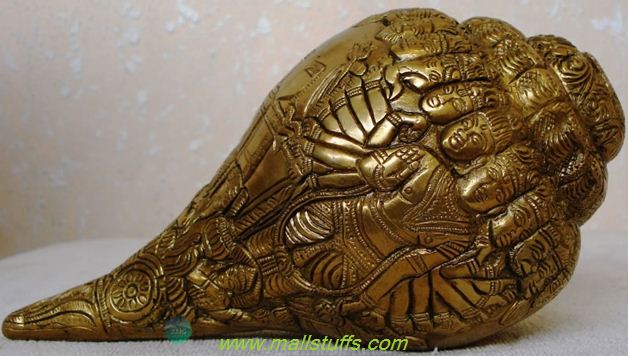
Similarly, conch of Yudhisthira, Bhima, Nakula and Sahadeva were called as Anantavijaya , Paundra, Sughosa and Manipushpaka respectively. Arjuna conch, known as battle horn, was used in war of Mahabharata to win over evil spiritis, avert natural disasters and sway dangerous animals.
पाञ्चजन्यं हृषीकेषो देवदत्तं धनञ्जयः ।
पौण्ड्रं दध्मौ महाशङ्खं भीमकर्मा वृकोदरः ॥
अनन्तविजयं राजा कुन्तीपुत्रो युधिष्ठिरः ।
नकुलः सहदेवश्व सुघोषमणिपुष्पकौ ॥
(Shri Krishna blew Panchajanya conch and Arjuna Devadatta. Poundra conch was blown by Bhima, Anantavijaya by Yudhishthira, Sughosha by Nakula and Manipushpaka by Sahadeva.)
When Lord Krishna blew his Paanchajanya conch before the start of Mahabharata war, the whole world trembled in fear as they listened to the tumultuous sound emanating from the conch. The mesmerizing sound waves were heard all around the world. With his blowing of conch, Lord Krishna announced the victory of good over evil.
Conch of lord Vishnu
Conch is the emblem of lord Vishnu. Brahma purana declares shankha as the abode of Lakhsmi and Vishnu. One hand of lord Vishnu is always shown with Shankha. No image or statue of lord Vishnu is complete without conch in one of the hands. Lord Vishnu conch, known as ‘Panchjanya’(five elements i.e water, fire, earth, sky and air), is the most powerful of all conch shells. During the churning of the ocean, on the request of the Devas, Lord Vishnu blew Paanchajanya conch to create such a tumultuous sound wave that most of the demon warriors went unconscious. Bathing in the waters released from conch is as sacred as taking a dip in river ganga. Padma purana asserts the same and states the abomination of sins/evils on bathing in conch water. Dakshinavarti Shankha is blown to invoke lord Vishnu consort ‘Lakshmi’ to shower wealth and prosperity.
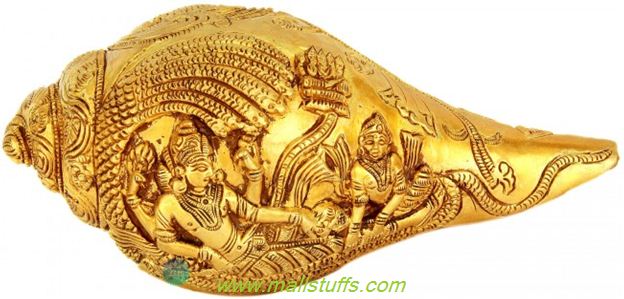
शालग्रामं च तुलसीं शङ्खमेकत्र एव च ।
यो रक्षति महाज्ञानी स भवेच्छ्रीहरिप्रियः ॥ (Brahmavaivarta P. 21.97)
The wise person who protects Shaligram stone, tulasi plant and conch shell together, he becomes beloved of Hari.
Conch of Naga (Snake) race and Buddhists